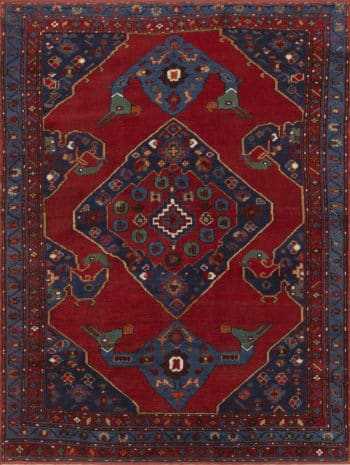Antique Central Anatolian Karapinar Rug Fragment 72606
Amazing Antique Central Anatolian Karapinar Rug Fragment, Country of origin: Turkish Rugs, Circa date: 1900 – This single fragment, a remanent of a once-grand rug woven by nomadic tribes, holds a profound significance that transcends its incompleteness. It serves as a precious thread connecting us to a captivating past, offering glimpses into nomadic life, symbolic expression, and remarkable weaving skills. Let’s embark on a journey to explore the significance of this Karapinar rug fragment and decipher the stories it whispers.
Central Anatolia (modern-day Turkey) boasts a rich textile tradition, with Karapinar rugs standing out for their distinctive designs and symbolic language. Crafted for centuries by nomadic tribes traversing the vast Anatolian steppe, these rugs served multiple purposes. They provided warmth and insulation within tents, acted as partitions separating living spaces, and were cherished possessions passed down through generations. The nomadic lifestyle subjected these rugs to constant wear and tear, and while the complete rug from which this fragment originates may no longer exist, this single piece offers invaluable insights into the artistic expression and cultural identity of these nomadic communities.
A defining characteristic of Karapinar rugs, evident even in a single fragment, is the prominent use of bold geometric patterns. These patterns, often repeated in intricate arrangements across rugs, served as a visual language communicating stories of tribal identity, religious beliefs, and aspirations. Common motifs, such as guls (eight-pointed stars) symbolizing celestial bodies and protection, or rams’ horns representing strength and masculinity, conveyed deeper meanings. Even though this fragment might display only a portion of a larger motif, it still holds significant meaning and serves as a treasure trove of symbolic imagery.
Another hallmark of Karapinar rugs is the vibrant use of colors. Natural dyes, derived from plants and insects, produced a rich palette of colors like reds, blues, greens, and yellows. These colors weren’t just aesthetically pleasing; they often held symbolic meaning as well. For instance, red might symbolize life force and protection, while blue could represent water or the celestial heavens. Even in a fragment, traces of these colors can hint at the original beauty and symbolic power of the complete rug.
Incorporating this fragment into your home is not just about adding a decorative piece; it’s about embracing a piece of living history. It’s about honoring the craftsmanship and ingenuity of Central Anatolian tribes while celebrating the timeless beauty of their artistic legacy. With each glance, this fragment tells a story, weaving together threads of tradition, symbolism, and human creativity into a tapestry of enduring significance.


















